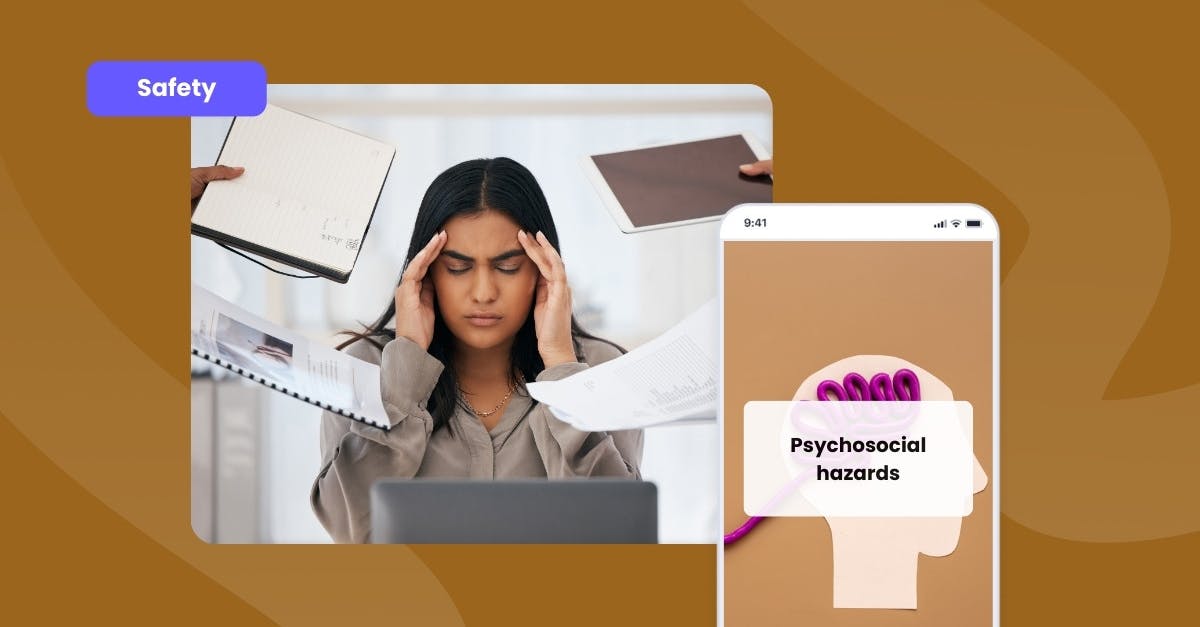8 Psychosocial hazards at work and how to manage them

A healthy work environment goes beyond physical safety. Psychosocial issues often fly under the radar, but they can lead to serious consequences, including increased absenteeism, decreased morale, and even higher turnover rates.
In this article, we’ll explore the different examples of psychosocial hazards, why they matter, and how you can identify and address them in your workplace.
What are psychosocial hazards?
Psychosocial hazards are factors in the workplace that can affect employees’ mental health and well-being. Essentially, anything that creates a negative emotional or psychological environment can be considered a psychosocial hazard. These may include low job control, workplace harassment, and a lack of support from supervisors or colleagues.
To manage psychosocial health and safety in the workplace, the International Organization for Standardization (ISO) developed ISO 45003. It’s the first international standard that offers guidelines for identifying and addressing psychosocial risks that can impact employee well-being.
Understanding ISO 45003 and recognising these hazards is crucial, as they can contribute to various health issues, including anxiety, depression, high stress, and burnout. They can also lead to unhealthy behaviors, such as poor diet, smoking, and aggression.
8 Psychosocial hazards in the workplace
While there are many psychosocial hazards examples out there, we’ve highlighted the eight most common ones you should watch out for.
High job demands
High physical, mental, and emotional job demands can be overwhelming for employees—especially when excessive workloads, tight deadlines, or challenging tasks push them beyond their limits.
It’s easy for stress to build up in these situations. When they feel like they’re constantly racing against the clock, it can take a toll on their well-being. This can further result in burnout, fatigue, and dissatisfaction.
Ways to manage this hazard:
- Clearly define achievable goals and deadlines to help prevent your employees from feeling overwhelmed
- Have regular check-ins to make sure they have manageable workloads.
- Simple changes, like prioritising tasks or redistributing work, can make a big difference and help everyone feel more balanced.
- Offer access to tools and resources that can help them manage their workload more effectively.
Low job control
Employees who have little say over how they do their jobs may feel frustrated or helpless. Low job control often stems from rigid work structures, micromanagement, and limited access to resources. This lack of control can leave employees feeling disengaged, as they might feel like they’re just following orders without having any input in their work.
Ways to manage this hazard:
- Include your team in decision-making processes related to their roles. This gives them a voice in how they complete their tasks and manage their time.
- Offer employee development training programs that enhance their skills and confidence, so they can take more initiative and control over their work.
- Encourage them to create their own goals and determine the best ways to achieve them.
Lack of support from coworkers or managers
Lack of support can show up in various ways, such as inadequate guidance from managers, insufficient collaboration among team members, or a general absence of encouragement and recognition.
Feeling unsupported at work can make it hard for employees to complete their tasks and can build resentment and conflict among team members.
Ways to manage this hazard:
- Plan regular team-building exercises to strengthen relationships among coworkers.
- Connect them with mentors who can offer guidance, support, and encouragement.
- Train managers in effective support strategies, highlighting the importance of being approachable and responsive to their team’s needs.
- Conduct regular check-ins where your employees can comfortably talk about their needs and challenges. This promotes psychological safety at work.
Job insecurity
Job insecurity refers to the fear or anxiety employees experience when they’re uncertain about their job stability or future employment. This can happen because of economic recessions, company downsizing, or shifts in management. Over time, uncertainty can lead to increased stress, anxiety, and a decline in overall mental well-being.
Ways to manage this hazard:
- Keep communication open about company performance and any changes that might be coming up.
- Identify employee development areas and offer clear career paths and opportunities to help them feel more secure and invested in their roles.
Poor work-life balance
Many employees find it challenging to juggle their work duties and personal lives. This psychosocial hazard often arises from long hours, excessive workloads, or a lack of flexibility in work arrangements. As a result, they may feel overwhelmed and unable to meet their personal needs.
In addition to stress and burnout, employees may feel guilty for not spending enough time with family or pursuing personal interests.
Ways to manage this hazard:
- Offer options like flexible schedules, hybrid or remote work, or compressed work weeks.
- Remind your employees to disconnect from work after hours and avoid checking emails or messages during their personal time.
- Support your team’s mental and physical health through wellness programs, such as mindfulness training, fitness classes, or stress management workshops.
Workplace bullying or harassment
Repeated, intentional harmful behavior directed at an individual or group can pave the way for a hostile or intimidating work environment. Workplace harassment and bullying can include verbal abuse, power-tripping, exclusion, and physical acts of violence. Those who witness or endure bullying may not feel safe, which can result in increased absenteeism and turnover rates.
Ways to manage this hazard:
- Develop and communicate clear anti-bullying and harassment policies.
- Teach your employees how to prevent, recognise, and respond to these situations through safety meetings and training.
- Set up safe and anonymous ways for victims to report incidents without fear of retaliation.
- Make sure they have access to peer support groups, counseling services, or mediation.
Social exclusion
Social exclusion happens when an employee feels isolated, marginalised, or ignored in the workplace. This can result from factors like discrimination, cliques, or not being included in team activities and decision-making processes.
If someone’s left out of discussions or team dynamics, they might feel a sense of disconnection from their colleagues and the organisation, as well as loneliness, anxiety, and depression.
Ways to manage this hazard:
- Actively encourage inclusion within your team to make everyone feel valued.
- Organise team-building activities and collaborative projects that involve all employees.
- Simple employee management gestures, like inviting quieter team members to share their thoughts, can help create a more welcoming atmosphere.
Unclear job roles
Unclear roles, expectations, and boundaries are also psychosocial hazards that need to be addressed. These can stem from poorly defined job descriptions, insufficient communication from management, or frequent changes in tasks and responsibilities. Not knowing what’s expected can lead employees to struggle with prioritising tasks or fear making mistakes, which can ultimately result in burnout over time.
Ways to manage this hazard:
- Create and share detailed job descriptions that outline specific responsibilities, expectations, and performance metrics for each role.
- Schedule regular one-on-one meetings between managers and employees to discuss roles, clarify expectations, and address any uncertainties.
Minimise psychosocial hazards and risks through training
Creating a supportive work environment starts with you. As an organisation, it’s important to recognise that mental health is just as vital as physical health for maintaining overall safety and productivity. To prevent and manage work-related health risks, you need to implement proper and effective psychosocial hazard training.
Training raises awareness of potential issues and equips both employees and managers with the skills needed for effective communication and conflict resolution. While it’s not the only way to manage these hazards, it’s one of the most effective methods for preventing them—and it’s a solution you have complete control over.
SC Training (formerly EdApp) has partnered with Skodel to create two courses specifically designed for Australian workers and organisations. Skodel is a psychosocial compliance organisation that helps businesses meet regulations related to psychosocial hazards, reducing their risk of penalties and ensuring they have the proper documentation for regulatory inspections.
While both courses focus on psychosocial hazards, they’re tailored to different roles and perspectives within the workplace. Let’s take a closer look at each course.
Psychosocial Hazards for Employees (AU)
Built with Australian regulators and psychologists, this course is designed to help employees identify and manage stressors in their work environment. It begins with an introduction to psychosocial hazards, explaining what they are and why they matter.
The course also gives several scenarios where your team will learn to recognise and prevent common hazards in the workplace, such as harassment and poor support. They’ll understand how these stressors can impact both their well-being and that of their colleagues. The course concludes with a final assessment to test your team’s understanding.
Psychosocial Hazards for Leaders (AU)
In addition to the course for employees, there’s one specifically designed for leaders. This course helps leaders understand and manage workplace stressors that can impact mental health, so they can foster mental well-being and promote a positive workplace culture.
Like the employee course, it begins with an introduction to psychosocial hazards and their significance in maintaining a healthy work environment. However, the main focus is on how to manage these hazards, equipping leaders with practical strategies to identify and effectively address these issues.
The course includes case studies that highlight successful approaches from other organisations. A final assessment is placed at the end as well.
Through these psychosocial hazards courses, you can help your employees manage stress while equipping your leaders with the tools they need to spot and tackle these issues within their teams. They come with a fully customisable checklist to help your organisation establish a structured approach to psychosocial risk management and promote continuous improvement.
These bite-sized courses are also designed to be compatible with any device, so your learners can complete them on the go. The best part? They’re free for up to 10 users, making it an affordable training solution for small teams looking to comply with the latest work health and safety laws.
Promote psychosocial well-being in your workplace through SC Training. Get started today.
Author
Ella Mar
Ella is a content writer for SC Training (formerly EdApp), an award-winning e-learning management system designed to help companies deliver high-quality workplace training. In her free time, she enjoys painting, reading, or playing with her cat.
